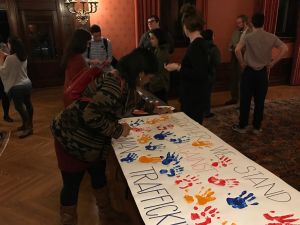The month of February was Human Trafficking awareness month. To honor that and to raise awareness for it, CRS University is began their I am Human Trafficking campaign. Throughout the month of February, CRS Ambassador chapters all over the country were encouraged to teach their campuses and plan events surrounding human

trafficking and what can be done to stop it and Cabrini’s CRS Ambassadors are were no different.
Feb. 8th was the feast day of St. Josephine Bakhita, the patron saint of human trafficking victims and in honor of her, Cabrini CRS Ambassadors hosted a guest speaker and encouraged all to stand in solidarity with those who have been or are being trafficked.
Human trafficking is becoming more and more common and effecting more and more people with everyday, but it’s still not very widely known. To begin to stop human trafficking people must first understand human trafficking.
What is it?
With $150 billion in revenue each year, human trafficking is the third most profitable form of organized crime, according to Catholics Confront Global Poverty. The UN Protocol to Prevent, Suppress and Punish Trafficking in Persons, defines human trafficking as “the recruitment, transportation, transfer, harbouring or receipt of persons, by means of the threat or use of force or other forms of coercion, of abduction, of fraud, of deception, of the abuse of power or of a position of vulnerability or of the giving or receiving of payments or benefits to achieve the consent of a person having control over another person, for the purpose of exploitation.” In simpler terms, it’s the buying and selling of people by using force and without their consent.
Human Trafficking can be broken up into two different types, Sex Trafficking and Labor Trafficking
Sex Trafficking is when “individuals perform commercial sex through the use of force, fraud, or coercion,” according to the National Human Trafficking Hotline. Sex Trafficking what what people most often think of when they think of human trafficking and with over 20,000 reported cases in the United States since 2007 it is the more prevalent form of human trafficking.
Sex Traffickers work out of any of a number of “normal” looking places like bars, hotels, clubs, massage parlors and similar places. Trafficking victims will usually have a “legitimate” job with in the business like a hostess or a bartender which makes it even more difficult to spot and shut down these types of places.
Labor Trafficking is similar to sex trafficking but force victims into hard labor instead of sex. It’s defined by the Human Trafficking Hotline as the use of “violence, threats, lies, and other forms of coercion to force people to work against their will in many industries.”
Labor Trafficking is spread across a number of industries, from agriculture to food service to factories to domestic work. There are also much fewer reported cases with just over 5,000 cases in the US since 2007.
In cases of both sex and labor trafficking there are significantly more cases than the ones reported. This is because traffickers are usually very careful in what they do so as not to get caught. Victims are also also not likely to come forward for a number reasons. They may be in the country illegally and are afraid of being caught, they may be afraid of their captors or they may be kept on such a short leash, so to speak, that they can’t even get away from to report is.
The International Labor Organization estimates that there a 20.9 million victims of human trafficking globally but not everyone is affected the same. According to CCGP “55 percent of forced laborers and 98 percent of sex trafficking survivors are women and girls.” Traffickers also prey on people who seem weak and vulnerable, people like migrants, refugees, illegal workers and displaced people, to name a few.
Therefore, this is something that the average american can over look very easily. They either don’t think of them at all or if they do think them, they think of them as prostitutes who choose their profession or workers who have stolen american jobs, not as victims who are forced into sex work or hard labor.
What is being done to stop it?
That then begs the question what is being to done to combat human trafficking and what can americans do to help stop it.
There is currently a bill going through Congress called The Business Supply Chain Transparency on Trafficking and Slavery Act of 2015. According to Representative Carolyn Maloney (D-NY), one of the people who proposed this bill, “This legislation simply requires businesses to publicly disclose what actions they have voluntarily undertaken to remove labor abuses from their supply chains.”
She goes on to say “Some companies may participate knowingly in human trafficking to pad the bottom line; others are willfully ignorant of where and how their inexpensive products are made; and still others simply do not know.” Regardless of whether they know about it or not, this bill is going to make companies more transparent with, and take more responsibility for what happens on their supply chain.
Americans can help by calling their representative and letting them know that they support this bill and want their representative to support it as well.
There are also organizations such as The Polaris Project and The National Human Trafficking Hotline that are very active in the fight to stop human trafficking. Visiting their sites and going to the “Get Involved” is a great way to see what the average person can do to help fight this.
Something else that is easy to get involved with is something called Dressember. Similar to the premise of No-Shave November, people pledge to wear a dress everyday during the month of December to raise awareness and money to help stop human trafficking.
Visit the Human Trafficking Hotline website to find the hotline number and to read about the warning signs for human trafficking.


